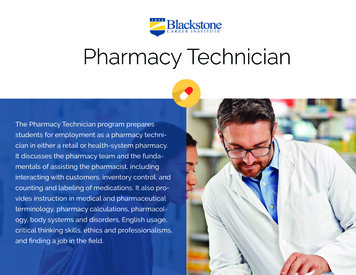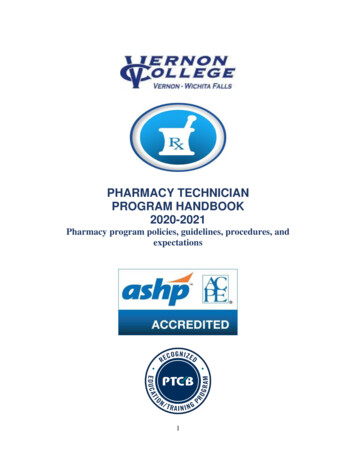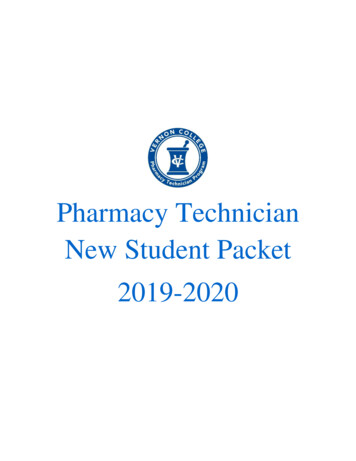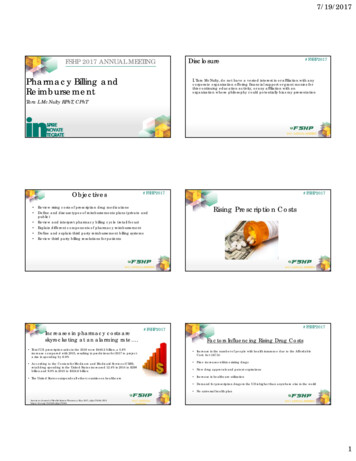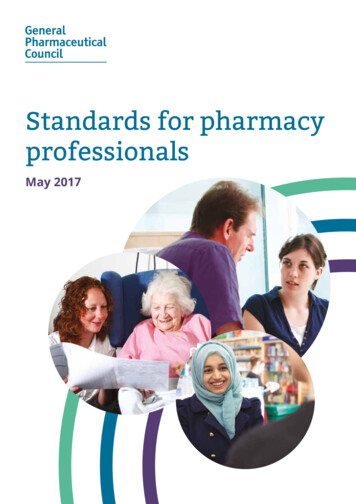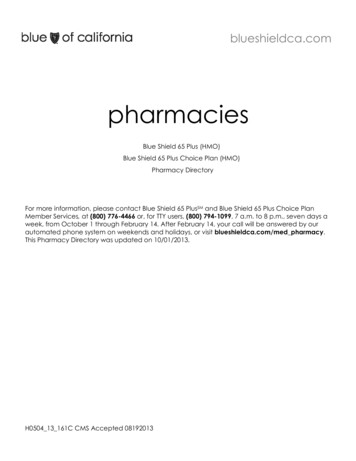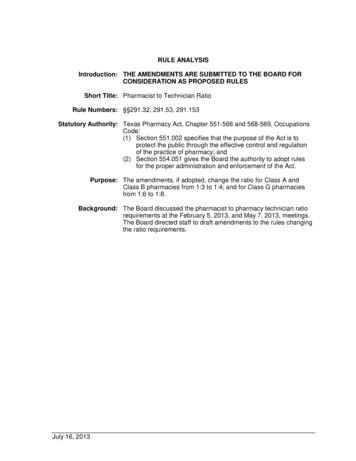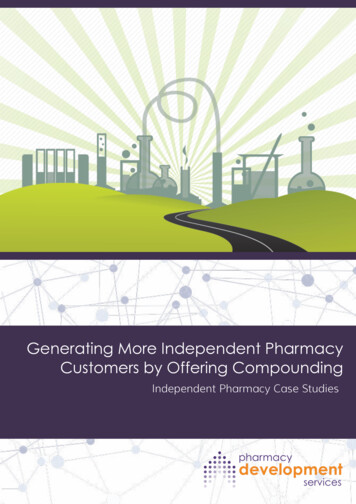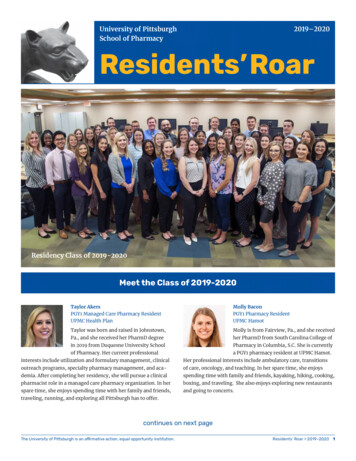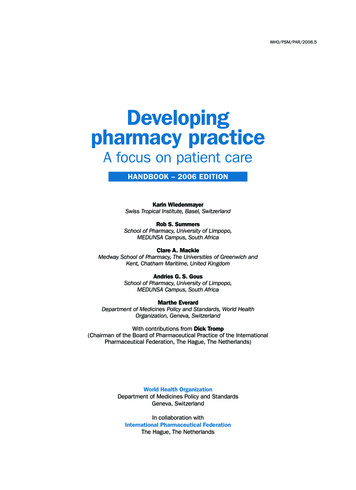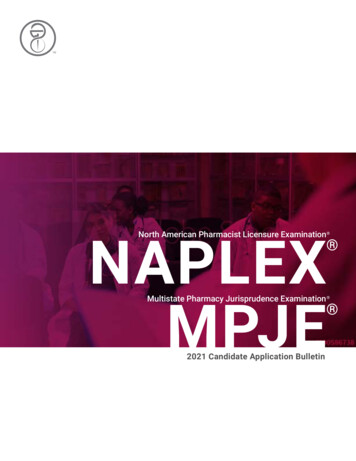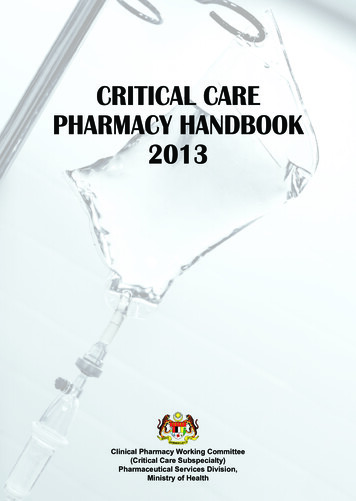
Transcription
CRITICAL CAREPHARMACY HANDBOOK2013Clinical Pharmacy Working Committee(Critical Care Subspecialty)Pharmaceutical Services Division,Ministry of Health
First Edition, December 2013Pharmaceutical Services DivisionMinistry of Health, MalaysiaALL RIGHT RESERVEDThis is a publication of the Pharmaceutical Services Division, Ministryof Health Malaysia. Enquiries are to be directed to the address below.Permission is hereby granted to reproduce information contained hereinprovided that such reproduction be given due acknowledgement and shallnot modify the text.Pharmaceutical Services DivisionMinistry of Health MalaysiaLot 36, Jalan Universiti,46350 Petaling Jaya,Selangor, MalaysiaTel: 603 – 7841 3200Fax: 603 – 7968 2222Website: www.pharmacy.gov.myPerpustakaan Negara MalaysiaCataloguing-in-Publication DataISBN 978-967-5570-48-3
MESSAGEThe discipline of critical care pharmacy practice evolvedover the years to become an essential componentof the multidisciplinary team in the intensive careunit (ICU). Pharmacists are required to work closely withother healthcare providers in promoting health, preventingdisease complications, as well as to assess and monitormedication use assuring that drug therapy regimens aresafe and effective.A description of pharmacy services and pharmacistactivities in a critical care setting will assist practitionersand administrators in establishing or advancing thisspecialized pharmacy services. This handbook elaboratesthe role of pharmacists and pharmacy services in the careof the critically ill patients. It presents information on thefundamentals of critical care practice from a pharmacist’sperspective. The availability of this handbook will guidethe critical care pharmacists in their practice and help inthe expansion of quality critical care pharmacy servicesthroughout Ministry of Health (MOH) facilities.I would like to commend the Clinical Pharmacy WorkingCommittee (Critical Care subspecialty), PharmaceuticalServices Division, Ministry of Health for their contributionand commitment to the publication of this handbook.Thank you.DR SALMAH BAHRIDIRECTORPHARMACY PRACTICE AND DEVELOPMENTPHARMACEUTICAL SERVICES DIVISIONMINISTRY OF HEALTH MALAYSIA
ADVISORDr Salmah BahriDirector of Pharmacy Practice & DevelopmentPharmaceutical Services Division, MOHEDITORIAL COMMITTEERosminah Md DinPharmaceutical Services DivisionMinistry of Health, MalaysiaAbida Haq SM HaqHospital Kuala LumpurSameerah Shaikh Abdul RahmanNational Pharmaceutical Control Bureau,Ministry of Health, MalaysiaNoraini MohamadPharmaceutical Services Division,Ministry of Health, MalaysiaNik Nuradlina Nik AdnanPharmaceutical Services Division,Ministry of Health, MalaysiaAzmira Akmal SateriPharmaceutical Services Division,Ministry of Health, MalaysiaWORKING COMMITTEEAida Roziana RamlanHospital Tengku Ampuan AfzanDatin Fadilah OthmanPharmacistAlia Hayati BaharudinHospital Tuanku FauziahFaridah YusofHospital Sultanah BahiyahAzrina Abd AzizHospital Sultanah BahiyahHasni HaronHospital Pulau PinangChe Wan Mohd Hafidz Che Wan AhmadHospital Tengku Ampuan AfzanJacqueline Lai Mui LanHospital Queen Elizabeth IChoo Yan MeiHospital Tengku Ampuan RahimahJannatul Ain JamalHospital Tengku Ampuan Afzan
Jerry Liew Ee SiungHospital Queen Elizabeth INur Murnisa MustaphaHospital Raja Perempuan Zainab IILim Chia WeiHospital MelakaNurdita HishamHospital Tuanku Ja’afarLim Shiao HuiHospital Pulau PinangPuah Ying JiaHospital Tuanku Ja’afarMartina Hu Sieng MingHospital Umum SarawakPuteri Juanita ZamriHospital SelayangMasrahayu MoydinHospital KemamanRahela Ambaras KhanHospital Sungai BulohMaznuraini ZainuddinHospital Raja Perempuan Zainab IIRohana HassanHospital Kuala LumpurMohd Shafie ZabidiHospital Sultanah AminahRos Sakinah KamaludinHospital Raja Permaisuri BainunNgua Ching ZinHospital Umum SarawakRoslita AliviHospital Sultan IsmailNoor Aziyah AzizHospital Kuala LumpurSiti Hir Huraizah Md TahirHospital MelakaNik Mah Nik MatHospital Tuanku FauziahTan Chee ChinHospital Sultanah AminahNor Haslina OthmanHospital Raja Perempuan Zainab IITeh Hwei LeinHospital Kuala LumpurNor Mazni Mohamed TamyesHospital Tengku Ampuan RahimahThong Kah ShuenHospital Raja Permaisuri BainunNorirmawath SaharuddinHospital Raja Permaisuri BainunYam Chiew FongHospital Kuala LumpurNorliza Mat AriffinHospital Selayang
CONTENTSCHAPTER 1. 81.1 THE ROLE OF PHARMACIST IN CRITICAL CARE. 81.2 CRITICAL CARE PHARMACIST ACTIVITIES. 8CHAPTER 2. 102.1 DEEP VEIN THROMBOSIS PROPHYLAXIS. 102.1.1Introduction. 102.1.2Definitions. 102.1.3Indications for Prophylaxis. 102.1.4Methods of Prophylaxis. 112.2 STRESS-RELATED MUCOSAL DISEASE. 162.2.1Introduction. 162.2.2Prevention Strategies . 162.2.3Stress Ulcers Prophylaxis in Patient with Nasogastric Feeding. 172.2.4Prophylaxis Agents For SRMD. 172.3 NEUROMUSCULAR BLOCKING AGENTS (NMBA) IN CRITICALLY ILL PATIENTS . 192.42.3.1Introduction. 192.3.2Neuromuscular Transmission and Blockade. 192.3.3Neuromuscular Blocking Agents . 202.3.4Complications of NMBAs. 212.3.5Monitoring Parameters. 222.3.6Special Population. 22SEDATION, ANALGESIC AND DELIRIUM IN CRITICALLY ILL PATIENTS . 262.4.1 Introduction. 262.4.2 Sedative Agents. 272.4.3 Analgesic Agents. 322.4.4 Management of Delirium. 352.5 FLUIDS IN CRITICALLY ILL PATIENTS . 372.5.1Distribution of Total Body Fluid (TBF). 372.5.2Crystalloid and Colloids. 372.5.3Fluid Resuscitation vs Fluid Maintenance. 382.5.4Osmolarity of Intravenous Fluids. 392.5.5Sodium. 392.5.6Potassium . 432.5.7Calcium, Ionised Calcium. 46
2.5.8Magnesium. 482.5.8Phosphate. 492.6 MEDICATION ADMINISTRATION THROUGH ENTERAL FEEDING TUBES . 512.6.1Introduction. 512.6.2Methods of Enteral Feeding Administration. 512.6.3Types of Enteral Formula. 522.6.4Types of Enteral Feeding Tubes. 522.6.5Drug Therapy Review. 522.6.6Types of Medication Formulation. 542.6.7Drug Interactions. 562.7 PROKINETIC AGENTS. 592.7.1Introduction. 592.7.2Types of Prokinetic Agents. 592.7.3Concerns on Use of Drugs as Prokinetic Agents. 602.7.4Other Prokinetic Agents . 62CHAPTER 3. 633.1 DOSE MODIFICATION IN RENAL IMPAIRMENT . 633.2 DOSE MODIFICATION IN LIVER IMPAIRMENT. 693.3 SPECIAL DOSING IN OBESE PATIENTS. 73CHAPTER 4. 764.1 PARENTERAL NUTRITION IN CRITICALLY ILL PATIENTS. 76CHAPTER 5. 795.1 DRUG CAUSING HAEMATOLOGICAL DISORDER. 795.2 POISONING. 81APPENDICES. 101APPENDIX 1: DRUGS THAT MAY UNMASK/EXACERBATE MYASTHENIAGRAVIS . 101APPENDIX 2: DRUGS AND CHEMICALS IN GLUCOSE-6-PHOSPHATEDEHYDROGENASE. 102APPENDIX 3: DRUG-DISEASE INTERACTIONS. 103REFERENCES. 107
CHAPTER 11.1THE ROLE OF PHARMACIST IN CRITICAL CAREThe discipline of critical care pharmacy practice evolved over the past 25 yearsto become an essential component of the multidisciplinary team in the intensivecare unit (ICU). In Malaysia, Clinical Pharmacy Working Committee (Critical CarePharmacy Subspecialty), Pharmaceutical Services Division (PSD), Ministry ofHealth (MOH) Malaysia has been established in 2006 to assist all phamacists in thecritical care setting in providing the best care to critically ill patients. Training centresin critical care pharmacy has also been established by PSD, MOH for short termattachment programme to train new pharmacists in critical care setting in ensuringthe best pharmaceutical care provided by pharmacists.Pharmacists established clinical practices consisting of therapeutic drug monitoring,nutrition support and participation in patient care rounds. Pharmacists also developedefficient and safe drug delivery systems with the evolution of critical care pharmacysatellites and other innovative programs.1.2CRITICAL CARE PHARMACIST ACTIVITIES Participates in ward rounds as a member of the multidisciplinary critical care teamto provide pharmacotherapeutic management for all ICU patients Performs medication history taking and medication reconciliation reviews todetermine which maintenance drugs should be continued during the acute illness Prospectively evaluates all drug therapy for appropriate indications, dosage, druginteractions and drug allergies Monitors the patient’s pharmacotherapeutic regimen for effectiveness and adversedrug reactions (ADR) and intervenes as needed Evaluates all orders for parenteral nutrition and recommends modifications asindicated to optimize the nutritional regimen Identifies ADR and assists in their management and prevention and developsprocess improvements to reduce drug errors Uses the medical record as one means to communicate with other health careprofessionals and to document specific pharmacotherapeutic recommendations Provides pharmacokinetic monitoring when a targeted drug is prescribed Provides drug information and intravenous compatibility information to the ICUteam Maintains current tertiary drug references Provides drug therapy related education to ICU team members Documents clinical activities that include general pharmacotherapeutic monitoring,pharmacokinetic monitoring, ADEs, education and other patient care activities8
Acts as a liaison between pharmacy, nursing and the medical staff to educate healthprofessionals regarding current drug-related procedures, policies, guidelines andpathways Contributes to the hospital newsletters and drug monographs on issues related todrug use in the ICU Implements and maintains departmental policies and procedures related to safeand effective use of drugs in the ICU Provides consultation to hospital committees such as Pharmacy and Therapeutics,when critical care pharmacotherapy issues are discussed Identifies how drug costs may be minimized through appropriate use of drugs inthe ICU and through implementation of cost-containment measures Participates in quality assurance programs to enhance pharmaceutical care Maintains knowledge of current primary references pertinent to critical carepharmacotherapy Participates in training pharmacy students, residents and fellows throughexperiential critical care rotations, where applicable Coordinates the development and implementation of drug therapy protocols orcritical care pathways to maximize benefits of drug therapy Participates in research design and data analysis where applicable Contributes to the pharmacy and medical literature for examples case reports,pharmacokinetic and pharmacoeconomic reportsAdapted from Position Paper on Critical Care Pharmacy Service. Prepared jointly bythe Society of Critical Care Medicine and the American College of Clinical Pharmacy.(Pharmacotherapy 2000;20(11):1400–1406)9
CHAPTER 22.1DEEP VEIN THROMBOSIS PROPHYLAXIS2.1.1IntroductionA vast number of critically ill patients have at least one risk factor for venousthromboembolism (VTE) and with other additional specific risk factors suchas respiratory & cardiovascular failures, obesity, smoker, surgery, trauma,malignancy, elderly, immobility and having central venous catheters.VTE which defined as an event due to thrombus formation is manifested asdeep vein thrombosis (DVT) or pulmonary embolism (PE). VTE is one ofthe most common and detrimental complication in these patients, attributingto about 10% of hospital mortality. Therefore, patients’ risk of developingVTE should be assessed (e.g. high, moderate to low risk) and appropriatepharmacological & non-pharmacological management should be commenced.2.1.2Definitions5DVT is defined as a clot that occurs in the deep veins of the extremities. Furthersub classifications include symptomatic versus asymptomatic and proximal(above the knee) versus distal (below the knee).PE is defined as being a clot usually originating from a DVT that travels to thepulmonary vasculature where it becomes an embolism and thereby impedesgas exchange distal to embolism.2.1.3Indications for ProphylaxisAll adult inpatients will be assessed for their risk of VTE that include thebackground history and acute or sub acute precipitating factors which areshown in Table 2. Clinicians will need to use their own judgment in addition tothe guideline to determine the best method of reducing the risk of VTE in eachindividual patient. It is the combined responsibility of the physician and otherhealthcare staff including the clinical pharmacist and nursing staff to ensure allpatients at risk for VTE have received appropriate prophylaxis when needed.1a.Low-risk groups 1 Patients with minor trauma or minor medical illness at any age, in theabsence of thrombophilia, previous DVT or PE. Patients undergoing minor surgery (duration under 30 minutes) at anyage, in the absence of other risk factors. Patients undergoing major surgery (duration over 30 minutes) who areaged under 40 years and have no additional risk factors.b. Moderate risk groups 1 Patients undergoing major general, urological, gynaecological,cardiothoracic, vascular, or neurological surgery who are aged 39years or with other risk factors Patients immobilised with acute medical illness Major trauma10
Minor surgery or trauma or illness in patients with previous deep veinthrombosis, pulmonary embolism, or thrombophilia.Table 2: Venous Thromboembolism – Risk Factors 6Background Factors Age 40 years Marked obesity ( BMI 30 ) Immobility / bed rest / pharmacologicalparalysis / sedation Pregnancy / Puerperium Stroke / spinal cord injury High dose estrogens Previous DVT or PE Thrombophilia- Deficiency of antithrombin, protein-Cor protein-S- activated protein-C resistance- antiphospholipid antibody or Lupus anticoagulantc.2.1.4Precipitating Factors Trauma or surgery, especially of pelvis,hip, lower limb Malignancy especially pelvic,abdominal, metastatic Cardiac / respiratory failure Recent myocardial infarction Paralysis of lower limb(s) Severe infection Inflammatory bowel disease Nephrotic syndrome Polycythemia Paraproteinemia Paroxysmal nocturnalhemoglobinurea Bechet’s disease Burns Mechanical ventilatorHigh-risk groups1 Fracture or major orthopaedic surgery of pelvis, hip, or lower limb. Major pelvic or abdominal surgery for cancer. Major surgery, trauma, or illness in patients with previous deep veinthrombosis, pulmonary embolism, or thrombophilia. Lower limb paralysis (for example, hemiplegic stroke, paraplegia). Critical lower limb ischaemia or major lower limb amputation. Spine fractureMethods of ProphylaxisThere are two method of prophylaxis of DVT, which are1:a. Pharmacological methods :- Standard heparin (usually in low dosage)- Low molecular weight heparins- Oral anticoagulant such as warfarin- Aspirin*Pharmacological prophylaxis should not be initiated in patients with high riskfactors of bleeding, unless the risk of VTE outweighs the risk of bleeding.b. Mechanical methods - increase venous outflow and/or reduce stasis withinthe leg veins :- Graduated compression stockings (GCS)- Intermittent pneumatic compression (IPC) devices- Venous foot pump (VFP)11
Table 2.1: Recommended DVT prophylaxis for surgical procedures and medical conditions neral SurgeryLow risk:minor procedures, 40years old, no additional risksNoneEarly ambulationHeparin, LMWH,ES, or IPCHeparin 5000 – 7500 iu bdORLMWH (daily dose according to manufacturer) with IPCor ES.* LMWH and heparin has comparable efficacy for DVTprophylaxis.8,9 The clinical advantages of LMWH overLDUH is its once-daily administration and the lower riskof heparin-induced thrombocytopenia (HIT), BUT LMWHis more costly.10Heparin , LMWHHeparin 5000 – 7500 iu tdsORLMWH (daily dose according to manufacturer)*In high-risk general surgery patients, higher doses ofLMWH provide greater protection than lower doses.3General SurgeryModerate risk:Minor procedure but withrisk factor, nonmajor surgeryage 40-60 with no risks, ormajor surgery 40 yearswith no risksGeneral SurgeryHigh risk:Non-major surgery over age60 or over age 40 with risks.General SurgeryLMWH combinedwith ES or IPCLMWH (daily dose according to manufacturer)*May consider post discharge LMWH or perioperativewarfarinLMWH or warfarinMay combine with ES or IPC; start LMWH 12 hoursbefore surgery, 12-24 hours after surgery, or 4-6 hoursafter surgery at half the dose for initial dose for at least10 days. Start warfarin preoperatively or immediatelyafter surgery, target INR 2.0-3.0. Extended prophylaxis isrecommended for up to 28 to 35 days after surgery. 8Elective Knee ReplacementLMWH or warfarinBoth LMWH and warfarin resulted in significantly fewerproximal DVTs compared with LDUH or IPC (p 0.006 foreach comparison).11 Pooled data from 5 trials that directlycompared LMWH with warfarin showed rates of proximalDVT of 3.4% and 4.8%, respectively.8Hip Fracture SurgeryLMWH or warfarinNeurosurgeryIPC, LDUH orLMWHTraumaLMWH with ESor IPCAcute Spinal Cord InjuryLMWHVery high risk:Major surgery over age 40plus prior VTE, cancer orhypercoagulable stateElective Hip ReplacementMechanical method is preferred, however if heparin is tobe initiated, it shall be administered post 48-72hrs of thesurgery.If high risk of bleeding, may use ES and/or IPC alone.Continue LMWH during rehabilitation or convert towarfarin (target INR 2.5).12
Surgery/ConditionIschemic StrokeESINRIPCRecommendedProphylaxisLDUH, LMWHCommentsIf contraindication to anticoagulant, use ES or IPC.Two studies directly comparing LDUH (5000 U threetimes daily) to LMWH (enoxaparin 40 mg once daily),using venography for diagnosis, found greater reductionin DVT with LMWH.8A meta-analysis of studies of hospitalized patients withconditions other than myocardial infarction or ischemicstroke given VTE prophylaxis with unfractionated orlow molecular weight heparin showed no significantdifference was found between LMWH and LDUH inincidence of DVT, PE, or mortality; however, majorhemorrhage was lower with LMWH than with LDUH (RR0.48, 95% CI: 0.23-1.00).12: elastic stockingsLDUH : low-dose unfractionated heparin: international normalized ratioLMWH : low molecular weight heparin: intermittent pneumatic compression VTE: venous thromboembolis.* Warfarin is hardly use in critical care due to administration problem, thus it is not recommended as first line.Table 2.2: Medications Used To Prevent DVTMedication ow molecular weight heparinEnoxaparinTinzaparin1720 mg SC daily(moderate risksurgery) OR40 mg SC dailyLow to Moderate(can go up to 30 mgriskSC q12h for high(generalsurgery):risk general surgery,3,500 anti-Factormajor trauma orXa IU SC 2hrsacute spinal cordbefore surgery andinjury)14postoperatively,Morbid obeseModerate risk3500 anti-Factor Xa( 150kg orIU ODSC Heparin 5000unitsBMI 35kg/m2):BDHigh risk0.5mg/kg SC q12hHigh risk/BMI 40or a 25% increase (orthopedic surgery):SC Heparin 5000from standard4,500 anti-Factorunits 8 hourlyprophylaxis doseXa IU SC 12hrs(using actual bodybefore surgery andweight).postoperatively onceRenal adjustmentdaily dose or, 50doseanti-Factor Xa IU/kg2hrs before surgery(CrCL 30 ml/followed by a oncemin)14daily dose.Prophylaxis dose:SC 20 mg dailyTherapeutic dose:1 mg/kg daily13Indirect Factor XaInhibitorFondaparinuxAdult ( 50 kg)2.5 mg SC oncedailyInitiate dose afterhemostasis hasbeen established,6-8 hourspostoperatively.16
Medication nMonitoringContraindication16Precaution165 days OR untilhospital discharge ifthis is earlier than 5days.Low molecular weight heparinEnoxaparinSurgical case147-10 days or longerif there is a risk ofDVT and until patientambulatory.Medical case146 – 14 daysPlatelet count, fullblood countRisk ofPlatelet count, fullthrombocytopeniablood count.(happen betweenRecommendation:5th and the 21stthe platelet count isday followingmonitored in patientsthe beginning ofreceiving heparin forenoxaparin therapy).more than five days,If significantand that heparin isdecrease (30 to 50%stopped immediatelyof initial count), theif thrombocytopeniatreatment shouldoccurs.be discontinuedand switch to otheralternative.Tinzaparin17Fondaparinux7-10 daysOrthopedicand abdominalsurgery155 to 9 days aftersurgeryIn patientundergoing hipfracture surgery9 to 24 days(consider the risk)Medical patientswith DVT risk6 to14 daysPlatelet count, fullblood countFull blood count,serum creatinine,and occult bloodtesting of stoolsare recommended.PT and APTTare insensitivemeasures.16- bleeding disorders- a history of allergy either to enoxaparin, heparin or other lowmolecular weight heparin 1Hypersensitivity todrug.May causethrombocytopenia.Discontinue andconsider alternativeif platelet are 100,000/mm3 or /andthrombosis develop.Recent orRecent oranticipated neuraxialanticipated neuraxialanesthesiaanesthesia(epidural or spinal(epidural or spinalanesthesia) areanesthesia) areat risk of spinal orat risk of spinal orepidural hematomaepidural hematomaand subsequentand subsequentparalysis. Considerparalysis.risk versus benefit.14Indirect Factor XaInhibitor- Hypersensitivity tofondaparinux- severe renalimpairment (CLCr 30 mL/min)- body weight 50 kg(prophylaxis)- active majorbleeding- thrombocytopenia- bacterialendocarditisSame withenoxaparin.Not to be useinterchangeable(unit-for-unit) withheparin, LMWH orheparinoids.
Medication ClassUnfractionatedheparinMedicationHeparinLow molecular weight heparinEnoxaparinIn neonate suggest to Consider risk versususe preservative freebenefit. Risk ofas some preparationthrombocytopenia.contained largeamount benzyl alcohol Caution in patientwith renal failure;( 100 mg/kg/day)dosage adjustmentthat can cause fatalneed for ClCr toxicity (gasping30mL/min.syndrome).Side effectDrug interactionThrombocytopeniaoccurs in about 3-4%of patients givenprophylactic heparin.Allergic reactions(including skinnecrosis), raisedserum transaminaseconcentrations, andosteoporosis with longterm use (especially inpregnancy)1Indirect Factor XaInhibitorTinzaparin17FondaparinuxRisk ofthrombocytopenia.Use cautionin patient withmoderate renaldysfunction.Patient with severehepatic impairmentwith elevation inprothrombin time. 10%- Fever, nausea,anemia161 to 10% risk16CNS: fever, confusion, painDermatology: erythema, bruising,hematoma at site of injectionGI : nausea, diarrheaHematologic : hemorrhage,thrombocytopeniaHepatic : ALT/ALP increaseIncreased effect/toxicity if use withanticoagulant,thrombolytics, dextranand drug affectplatelet function (e.g.aspirin, NSAIDs,dipyridamole,ticlopidine,Increased effect/toxicity if use withclopidogrel),anticoagulant, thrombolytics, dextrancephalosporinsand drug affect platelet function (e.g.which contain MTTaspirin, NSAIDs, dipyridamole, ticlopidine,(methylthiotetrazole) clopidogrel), cephalosporins which containchain (e.g.MTT chain and parenteral penicillins (maycefoperazone highinhibit platelet aggregation).16dose 6g) andparenteral penicillins(may inhibit plateletaggregation). 16Decreased effect ifuse with Nitroglycerin(IV) that may occur inhigh dosages. 161- 10%Edema, hypotension,insomnia, dizziness,headache,confusion,rash, purpura,bullous eruption,hypokalemia,constipation,vomiting, diarrhea,dyspepsia, moderatethrombocytopenia,increase in liverenzyme. 16Increased effect/toxicity if use withanticoagulants,antiplatelet agents,drotecogin alfa,NSAIDs, salicylatesand thrombolyticagents.16All disposableTo avoid loss oftinzaparin syringesmedicinal productcontain an air bubble when using prefillwhich does not have syringe do not expelto be pressed outthe air bubble frombefore administering the syringe beforethe injection.the injection.15There is an increasedrisk of woundhaematomas, whichSpecial instructioncan be minimised byavoiding injectionsclose to wounds.115
2.2STRESS-RELATED MUCOSAL DISEASE2.2.1IntroductionStress-related mucosal disease (SRMD) is an acute condition which erosionof the gastric mucosa occur secondary to a physiologic stress.1 SRMDencompasess with 2 types of mucosal lesions which are stress-relatedinjury, (diffuse, superficial mucosal damage) and discrete stress ulcers (deepfocal lesions that penetrate the submucosa).9 Clinical trials have estimatedgastrointestinal (GI) bleeding in 3% to 6% of intensive care unit (ICU) patients.The etiology of SRMD is multifactorial and complex. Patients with head injuryor burns are at the highest risk of SRMD due to gastric acid secretion resultingfrom vagal stimulation. Other critically ill patients appear to develop SRMDas a result of diminished mucosal defenses and hypoperfusion. 4 The longerthe gastric pH remains below 4 the greater the risk of hemorrhage. There isa strong relationship between duration of mechanical ventilation, duration ofintensive care stay and incidence of ulceration.5In critically ill patients requiring mechanical ventilation and use of a nasogastrictube, acute GI bleeding may become clinically evident, with a bloody gastricaspirate or the appearance of coffee ground materials in the gastric aspirate.Hematemesis or melena may be the first sign of bleeding in patient withoutnasogastric tube. Unexplained hypotension or a decrease greater than 2g/dLin hemoglobin level should prompt evaluation for bleeding in the upper GI tract.2.2.2Prevention Strategiesa. High risk patient 3,13 – all patients to receive prophylaxis- M
critical care setting in providing the best care to critically ill patients. Training centres in critical care pharmacy has also been established by PSD, MOH for short term attachment programme to train new pharmacists in critical care setting in ensuring the best pharmaceutical care prov
